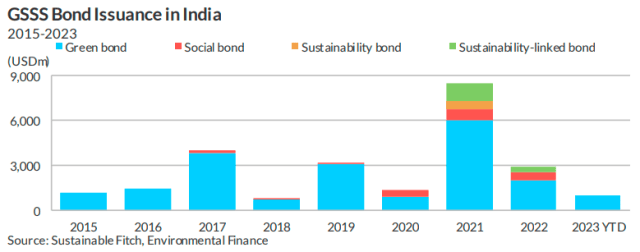The sovereign green bonds issued by India reflect the policy focus to scale up financing capacity on climate mitigation and adaptation.
Fitch said it expects the bonds to be held largely by domestic investors, incentivised by the national climate policy to mobilize financing resources for green activities.
Download Fitch report on India’s Sovereign Green Bonds May Bolster Financing
The first issuance in January 2023 comprised two tranches, with five-and 10-year maturities, totalling INR 80billion (USD 1billion). A second offering, also comprising of two tranches with five- and 10-year maturitiesraised an additional INR 80billion on 9 February.
Proceeds from the sovereign green bonds will go towards projects that meet India’s decarbonisation targets, which include achieving net-zero emissions by 2070, reducing emissions intensity of GDP by 45 percent by 2030 over 2005 levels, and increasing the share of non-fossil fuel energy resources to 40 percent by 2030.
India government published its Sovereign Green Bond Framework in October 2022, aligning itself with the International Capital Market Association’s Green Bond Principles. The framework identifies how the proceeds from green bonds will be allocated to projects such as renewable energy, energy efficiency, clean transportation, sustainable water and waste management, and green buildings.
The outstanding amount of GSSS1 bonds issued by Indian entities stood at $19.17 billion by December 2022, making up roughly 3.8 percent of the overall outstanding corporate bonds in India. In terms of issuance, green bonds accounted for the majority of labelled bonds issued in India, accounting for a total of $20 billion by January 2023.
Indian green bond issuers are concentrated in the energy sector, dominated by large energy companies using the proceeds to build renewable energy projects, particularly solar.
A study by the Climate Policy Initiative pointed to the difficulty for many entities in India’s infrastructure sector to access financing through the local capital market, due to lower credit ratings, lack of credit guarantees, and less investor demand for local bond issuance. This has contributed to a shallow domestic sustainable debt market, in contrast to the large amount of infrastructure capital being allocated to renewable energy in India – an estimated USD14.5 billion in the 2020-2021 fiscal year, according to data from the Institute for Energy Economics and Financial Analysis.
The Indian government has introduced a number of incentives to accelerate investment in renewable energy. The Make in India initiative seeks to boost the domestic manufacturing base for renewable energy, including wind turbines and solar components.
According to forecasts by Fitch Solutions, renewables generation will experience the largest growth of all India’s power types, with annual average growth of 8.7 percent from end-2022 to 2032. The costs associated with reaching net-zero emissions by 2070 are massive.
Research from an Indian think-tank, Council on Energy, Environment and Water, indicates India will need cumulative investments of USD10.1 trillion to scale up generation from renewable energy and associated generation, distribution and transmission infrastructure.

